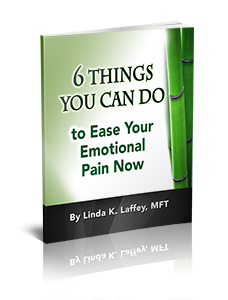by Linda K. Laffey, MFT
The idea of therapy does not appeal to everyone. In fact, the idea of confronting problems and attempting to change them can be downright scary.
Although one’s depression may seem intolerable.
Despite the leftover pain, shame, and humiliation from physical or sexual abuse.
Even if persistent memories and Post-Traumatic Stress Disorder (PTSD) make life miserable.
Though many people are suffering from deep emotional or psychological pain, the imagined hours of talking, recalling, and returning week after week for therapeutic work simply keep some of them from picking up the phone and calling a therapist for help.
But, thankfully, there is more than one way to find relief and healing.
A powerful methodology called Eye Movement Desensitization and Reprocessing (EMDR) is a highly touted and respected treatment, proven to be safe and rapidly effective for the treatment of problems stemming from anxiety, depression, eating disorders, trauma, and much more.
This type of treatment can play a vital role in helping you, or someone you care about, process past trauma, abuse, or neglect in half the time of traditional therapy.
What makes EMDR such a time efficient approach?
1. The goal of EMDR therapy is to thoroughly process the feelings associated with the experiences that are causing problems, and to replace them with new ones that are needed for optimal functioning. “Processing” does not mean talking about it. “Processing” means setting up a learning state that will facilitate a reduction in the intensity of feelings associated with problematic memories or experiences. It allows them to become “digested” and stored appropriately in your brain. That means that what is useful to you from an experience will be learned, and stored with appropriate emotions in your brain, and be able to guide you in positive ways in the future.
This means you are not stuck with leftover emotions, physical responses, ideas, and therapies that don’t serve you well. You can leave them behind to quickly and more beneficially pursue healthier perspectives and relationships.
2. EMDR therapy assumes that your brain wants to heal. It may be that some disturbance or trauma is simply blocking the natural healing process beyond your conscious awareness. Anxiety and stress dissipate rapidly and significantly, because EMDR accesses mental processing and reasoning that were previously unreachable through the passage of time, therapy, or drug treatment.
EMDR goes about the business of removing mental blocks that impede healing– without assuming that healing requires a long period of recovery.
3. Your Certified EMDR Therapist helps you draw important mental connections, and assists in transforming your emotional responses through bilateral stimulation. The process employs a standardized treatment protocol focused on past memories, present trouble, and future action to achieve healing. Some research reveals that between 80 to 90 percent of single-trauma victims are free of PTSD symptoms after three 90-minute sessions.
EMDR can provide effective, lasting treatment in as few as 3-5 treatments, depending on the depth and breadth of your trauma, phobia, or disorder.
4. Homework is not required. Progress may be slowed by a reluctance or unwillingness to complete outside assignments. EMDR is not dependent on that type of work, though some therapists may suggest a journal of meaningful feelings or memories, as well as other adjunctive assignments that can speed up the healing process.
EMDR Therapy is straightforward and focused each time. The work primarily takes place during sessions as you, guided by your therapist, follow a protocol combined with bilateral stimulation to target your fear, trauma, or pain.
5. The insights gained through EMDR are primarily obtained by your own enhanced processing of your experiences, rather than your therapist’s interpretation of your experiences.
Because you are largely in control, you feel empowered to move forward and embrace the therapy, stick with it, and make changes faster.
6. Intense feelings of relief, sometimes temporary vulnerability, and emotional readiness are not uncommon following EMDR sessions. The shift in mindset often creates a better framework for making lasting changes and improved choices.
When you know progress is being made and actually feel better, recovery is facilitated more readily and healthily.
I have been a Certified EMDR Therapist since 2004, and I am still in awe of the amazing results I have seen, both personally and professionally, doing this work. Just about everyone I know who has experienced this therapy has reported significant improvement in every area of their life. When you’re ready to explore what EMDR and other somatic therapies can do for you, please give me a call. You will not be disappointed.
I look forward to hearing from you.
Linda K. Laffey, MFT
(805) 375-5860

